
Most airlines only offer lounge access to business and first-class ticket holders. But this All Nippon Airways lounge in Tokyo also welcomes passengers with premium economy tickets. In addition to ANA, Japan Airlines, SAS and LATAM now offer airport hospitality to premium economy passengers. Photo by Jo Panuwat D at Shutterstock
By Riley Pratt
If you spend a lot of time in the sky, it’s important to consider the quality of your travel experience. If your airport adventures are always bustling, harried, or nerve-wracking, you’ll burn out on flying before you even reach your destination.
To remedy the chaos of air travel, airports provide lounge spaces to shield and rejuvenate fliers—for a price. The lounge offerings can vary from a quiet place to work and eat to top-of-the-line restaurants equipped with sleeping rooms, massage parlors, and entertainment centers. And the life of one of these lounge visitors may not be as out of reach as you think. From credit cards to Priority Passes, here’s how to step away from the mess of an airport terminal and into a lounge.
The Way of Priority Pass
The quickest way to escape chaotic airport halls and crowded gates into a lounge is to subscribe to Priority Pass. Priority Pass owns and operates 1,700 airport lounges worldwide, equipped with free WiFi, complimentary refreshments, and even conference rooms and beds (in certain locations). As Gary Leff, founder of View from the Wing, puts it, airport lounges must provide a “baseline” of services.
“Ideally it is quiet and secluded, comfortable seating, power outlet, some food and drink, private bathrooms that are cleaner than the main terminal,” he listed. “That’s the baseline.”
The quickest way to access these lounges is with a Priority Pass membership—which they can buy directly from Priority Pass or receive through a credit card premium plan. For now, we’ll focus on the first option.
Priority Pass offers 3 tiers of membership. For the occasional traveler, there’s the Standard Priority Pass—after paying the $99 annual fee, members pay $35 for each lounge visit (as well as $35 per additional guest in their party).
The second membership tier is the Standard Plus Priority Pass. For $329 per year, users have 10 free lounge visits (then every subsequent visit costs the same $35, for the user and each of their guests).
The Prestige Priority Pass is the highest and most expensive membership tier, at $469 per year. At this level, all the user’s visits to lounges are free—they only must pay $35 to admit guests. This is the level Priority Pass recommends for frequent travelers.
Besides differences in the cost of entry, there are no exclusive benefits or perks to having a higher membership plan. Amenities within the lounges are available to all members—and even perks outside the lounges. Priority Pass holders are entitled to one free massage or aromatherapy service in Be Relax spas, one free hour at Minute Suites (and discounts on additional time), discounted rates at car rental services, and dining credits toward participating restaurants.
While not physically connected to the lounges, seven small Be Relax airport spas are partnered with Priority Pass, all located in U.S. airports: Dallas-Fort Worth, Detroit Metro Airport, LAX, JFK, LaGuardia, and San Diego. Treatments like a 30-minute back massage in one of the 3-6 automated chairs, a 10-minute head and facial massage, or a 10-minute foot massage (the latter three combined with a 10-minute aromatherapy session) are free for Priority Pass members.
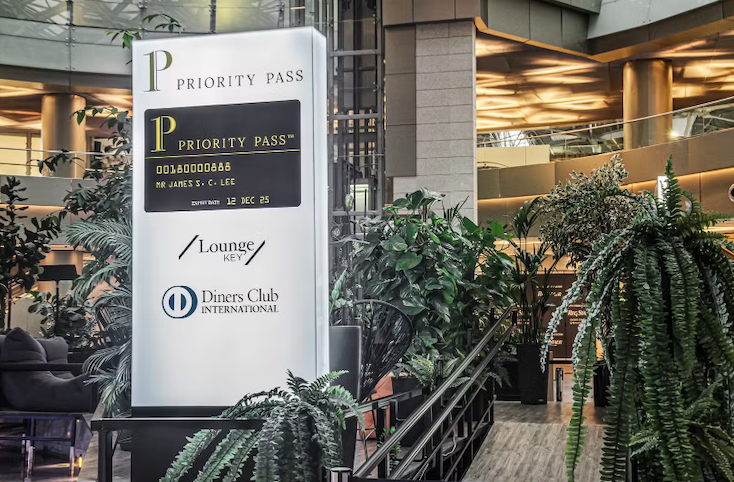
Similarly, Minute Suites are an escape from airport chaos while not being connected to lounges—they’re small (about 56 sq. feet), private rooms equipped with thermostats, trundle beds, desks, chairs, and TVs. Located in ten U.S. airports, travelers can pay by the hour. The communal bathrooms include showers as well. Normally, the rate is pretty steep—$55 for the first hour, $110 for the second, and up to $380 for eight hours. With Priority Pass, the first hour is free, and the following hours are at heavily discounted rates—$34 for two hours, up to $238 for eight hours.
Users can manage and navigate these packages, credits, and membership plans through Priority Pass’s app. Priority Pass sends its members physical cards to gain entry to their lounges, and users who prefer the convenience of a digital card always available on their phones have that option too (through the “Card” tab on the Priority Pass app). Entering the lounges works the same with either card: showing the card to the lounge attendant, having it scanned, and carrying on. If a member is worried about lounges being crowded, they can even use their phones to pre-book a lounge visit, reserving a spot to relax later.
If you’re flying to a big, busy airport, you’ll want to use that pre-booking feature. Overcrowding is the biggest issue for airport lounges. The biggest obstacle business traveler and architect Thomas DeVoss has noticed in his lounge experience is lounges reaching their capacity too quickly.
“A couple of times I get to the airport super early, thinking I’ll just do some work, and that doesn’t happen because [the lounges] are so popular,” he noted. “You don’t always just get in. Only one out of the last four times have I just arrived, shown my card, and gone into the lounge without any issues. But it’s not an indictment on the lounge, just an observation on their popularity, right?”
Interested travelers can buy a Priority Pass membership through their website—but that’s not the only way. As mentioned, certain credit cards also open doors to airport lounges.

In 1939, Airlines opened the first invitation-only airport lounge in New York. They named it the Admirals Club. Photo courtesy of American Airlines
Your Credit Card as a Key to Comfort
These days, most people getting Priority Pass memberships aren’t buying them directly from Priority Pass—they’re getting them through credit card rewards programs.
American Express, Chase, and Capital One all have complimentary Priority Pass memberships—each activated in different ways. To offer an even more exclusive experience, they have or are initiating networks of airport lounges just for their cardholders.
As Leff explains, “I know that for me, I’m visiting credit card lounges more than Priority Pass lounges. There are probably more people who’re members of an airline lounge [network] than who’re using Priority Pass cards—and that wasn’t true ten years ago.”
With American Express’s Platinum Card, cardholders activate their Priority Pass membership with a phone call to the Platinum Card Travel Service ((800) 801-6564). Beyond Priority Pass, American Express has dominated the market of credit-card airport lounges with their Global Lounge Collection—over 1,400 lounges across 500 airports, only accessible with the Platinum Card.
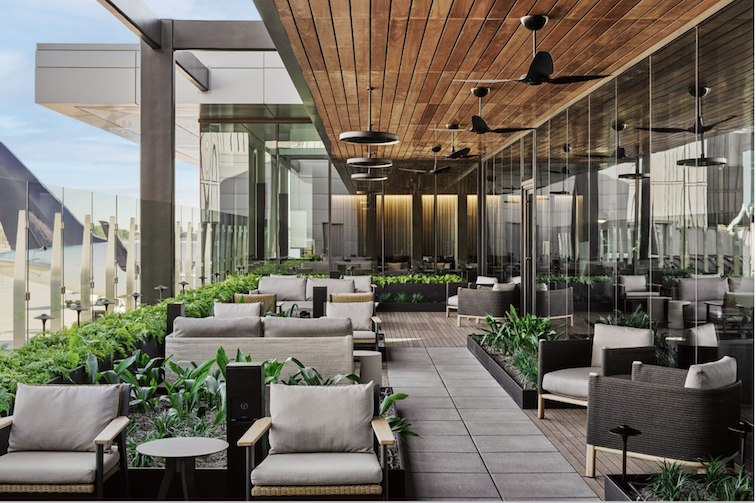
American Express’ 29th Centurion Lounge is at Washington DC’s Ronald Reagan National Airport. The space offers views across the airfield and Potomac River and a menu featuring dishes for award-winning chefs. The lounges tend to be located at international hubs (DEL, EZE, BOM, MEX, SYD, MEL, ARN and HKG) where international passengers need a place to relax before a long-haul flight. Photo courtesy of AMEX.
Chief among these offerings are American Express’s Centurion Lounges, which elevate the lounge experience with curated menus, wine lists, spa services, and even rooms designed for wine tastings. Only 29 of these elite lounges exist, with the latest opening last summer in the Ronald Reagan National Airport (DCA). Access to the Centurion lounges can’t be gained without the American Express Platinum cards or Delta SkyMiles Reserve American Express cards—even for other American Express cardholders, entry to these lounges can’t be purchased.
In the past two years, Chase has broken into the airport lounge industry, opening eight lounge locations internationally since October 2022. They plan to build more lounges, called Chase Sapphire Lounges by The Club, through 2025.
“We just opened the Phoenix and San Diego lounges,” Michael Sinatra, the head of external communications for Chase, explained. “And we have a lounge coming early next year in Philadelphia. Las Vegas and then LAX are in our pipeline as well.”
Chase Sapphire Reserve, J.P. Morgan Reserve, and Ritz-Carlton Rewards Credit Card cardholders can all access the Chase Sapphire Lounges, plus up to two free guests per card visit (additional guests for $27). While waiting for more Chase lounges to open up, cardholders can activate their Priority Pass membership online by signing in to their Chase Ultimate Rewards account, navigating to their card, “Card Benefits,” “Travel,” then clicking “Complimentary Airport Lounge Access” to start their membership. Chase sends their cardholders a physical Priority Pass card, and the digital one is available instantly.
Capital One currently operates four lounge locations, all in the U.S.: at the Dallas Fort Worth International Airport (DFW), Dulles International Airport (IAD), Denver International Airport (DEN), and the Ronald Reagan Washington National Airport (DCA). Wellness is at the heart of their lounge strategy, with the DFW lounge offering Peloton bikes and yoga rooms, and the DFW and DEN lounges having “relaxation rooms” with nap pods, blankets, and eye masks. Two other Capital One lounges are in the pipeline at the Harry Reid International Airport (LAS) and the John F. Kennedy International Airport (JFK).
Access is granted to their Venture X cardholders, plus complimentary entry for up to two guests (additional guests for $45). To activate the membership, cardholders can visit the Venture X Priority Pass page, enter their card information and billing details, and join.
These cards and their programs come with fees attached—$695 per year for the Amex Platinum Card, $550 per year for the Chase Sapphire Reserve Card, and $395 per year for the Capital One Venture X Rewards Card.

Inside Boston’s Logan Airport, there are several Delta SkyClubs located close to Delta departure gates. Buying a first or business-class ticket does not guarantee entrance to an airport lounge. Many airlines now sell business-class tickets without lounge access. In the U.S. today, airport lounge access often depends on payment arrangements or credit card membership. Photo courtesy of Massport
But which is better: buying a Priority Pass membership on its own, or getting a credit card that has the membership as a benefit?
Platinum, Sapphire Reserve, and Venture X card rewards programs are designed with travelers in mind. In addition to lounge access, benefits range from hotel credits, airline fee credits, car rental and Uber credits, increased points gained from hotel and flight purchases, and more. For a frequent flier, all of these benefits combined may make the annual fees worth it. However, for someone traveling less often, the Standard Priority Pass membership (at $99 per year) is the more financially practical option for lounge access.
In Leff’s opinion, the credit card route is a much better deal for the frequent traveler. “You’re getting a whole bundle of value in those cards where the Priority Pass is just one piece of it,” he explained.
Robert “Sonny” McDonald, the senior training manager at Toyo Tires, travels about 40 weeks out of the year for work—so in his opinion, the Amex credit card pays for itself.
“If you think about the food cost, drinks, and everything else [in airports]—you’re looking at a minimum of $40. So if you’re traveling in an airport twice a week, maybe four times, you’re looking at close to $160 per week,” he explained. But with the complimentary food and drinks in lounges, that cost is mitigated. “If you’re on the road at least once to twice a month, I think it does pay off,” McDonald concluded.
DeVoss exclusively uses Amex lounges, which he accesses with the Platinum card. But the decision was something of a toss-up between Amex and Chase.
“It came down to Chase Sapphire or Amex card,” he says, “and I ended up choosing Amex mainly because I like the look and feel of the card more. The lounges offer similar things.”
Top-of-the-Line Lounges
No matter who owns and operates it, be they Priority Pass or a credit card company, a lounge is a lounge. It’s a place to escape the chaos of the airport halls, have a quiet space to work or refuel with food and rest.
If you’re McDonald or DeVoss, it’s exclusively a place to work. “Most business travelers,” McDonald said, “we like to have our workspaces, so we need a place where we can hook up our laptops, charge them, and then have some area where we can have a Teams call or get emails done.”
DeVoss agreed. “You’ve got to have a place to work. That goes without saying.”
It doesn’t have to be anything fancy—but when a lounge goes above and beyond for its guests, it can be not just a relaxing, but unforgettable experience.
Priority Pass issues Excellence Awards to the highest-rated lounges in their network (decided by nearly 380,000 member ratings and reviews), judging them based on quality of the facilities, customer service, menu curation, and guest satisfaction overall. In 2024, the North American Lounge of the Year was the VIP Lounge Aguascalientes, located in Aguascalientes International Airport (AGU) in Mexico. The runner-up for North America was the Escape Lounge in Syracuse Hancock International Airport (SYR) in New York. Both were commended for their “vibrant” food and drink menus.
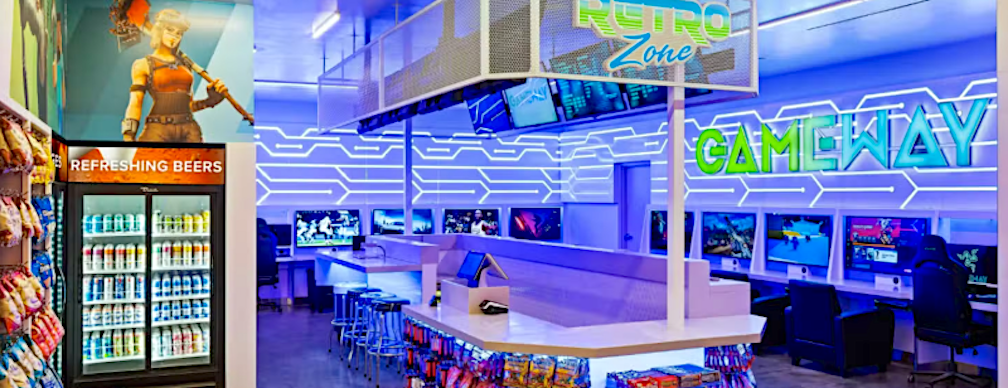
Priority Pass members visiting Gameway at Los Angeles International Airport have complimentary access to one hour of gaming and discounts on each additional hour—plus a snack and beverage.
There is also an Excellence Award for Priority Pass’s Pioneer of the Year—in 2024, that honor goes to Gameway, a video game lounge in Los Angeles International Airport (LAX) stocked with video game consoles and a retro game bar for waiting travelers to enjoy. Priority Pass members visiting Gameway have complimentary access to one hour of gaming and discounts on each additional hour—plus a snack and beverage.
A lounge doesn’t have to be award-winning to be memorable, though—or offer unique experiences. Amex’s Centurion Lounge in terminal 4 of JFK is a hidden speakeasy. LaGuardia’s two-story Chase Sapphire Lounge holds 2 meditation pods and a complimentary facial spa treatment. Atlanta’s Centurion Lounge has an outdoor deck area—something McDonald prized.
“On concourse F, [Amex] has a beautiful lounge,” he described. “It’s nice when you’ve been sitting in a plane all day, you go to this lounge and all of a sudden you’ve got a nice outdoor area just to chill out. At LAX, they have a beautiful outdoor space as well. Those are my favorite.”
But awards, gaming, and unique offerings don’t speak to every traveler. For Leff, the secret to elevating a good lounge to a great lounge lies in the lounge’s design and how the experience is personalized for guests. As an example, he cites the Ronald Reagan Washington National Airport (DCA).
“I think the American Airlines Admirals Club draws design elements from the city in very subtle ways throughout. It happens to be an incredibly architecturally well-done space and is beautiful,” he says. “I think that the Centurion Lounge has better food offerings than that American Airlines Admirals Club, but I’d rather spend time in that Admirals Club.”
DeVoss agreed—as an architect, he thought pulling inspiration from the airport’s home city was a nice touch. “I think that if you’re designing Amex or Chase lounges, they should all feel the same, but have a nod to the culture where they’re based. So they all have a similar feel—so you know you’re in an Amex lounge—but it would speak to the city.”
Between lounge design aesthetics and menu offerings, for Leff—who also uses lounges as a place to catch up on work—aesthetics are more important and more memorable. One of his favorite lounges in the world draws its design inspiration from its location: the Al Safwa First Lounge in Hamad International Airport (DOH) in Doha, Qatar.
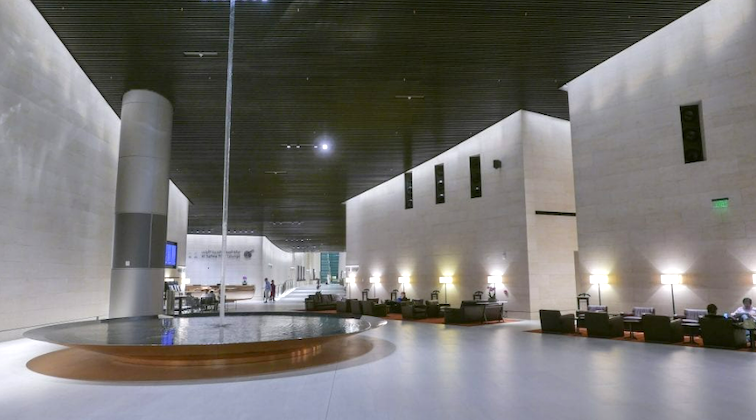
The Al Safwa First Lounge has several pieces of Islamic Art on loan from Doha’s Museum of Islamic Art.”
“I’ve had people tell me they think that [the lounge] reminds them of a museum. And I tell them, not only does the lounge itself maybe remind you of a museum it its design, it has several pieces on loan from the Museum of Islamic Art,” he explains. “There are 13th-century artifacts you can look at in the lounge!”
But at the end of the day, the most memorable lounge experiences of all are the ones where the lounge goes above and beyond for their guests, personalizing the lounge stay and accommodating a customer’s needs. McDonald appreciates lounges with an element of seasonality: “When I was traveling in December, [lounges] would offer a nice hot chocolate bar, where you can make your own with your toppings in it. Having that level of service, that’s also important to me.”
Leff recounted one story from his time in the Vancouver airport lounge, where the staff invited him, his wife, and his young daughter to use an empty VIP room—and made them a tomahawk steak.
“So, we had our private room, and a tomahawk steak before the flight,” he said appreciatively. “It’s perfect.”
What Makes It Worth It?
Airport lounges are a balm for the stress and confusion of modern air travel—a simple solution for travelers looking for a reprieve, a place to stop during their layover, a place to work, eat, and rest.
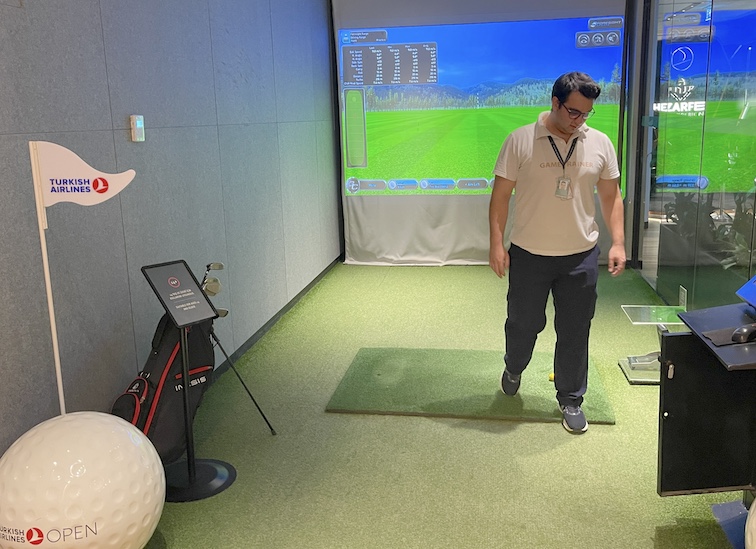
Tee time in Turkey. At the Turkish Airlines lounge in Istanbul, passengers with time to kill have the services of a Game Trainer who will explain how to play virtual golf. Photo by David DeVoss
“I just want to feel comfortable,” McDonald says “because you’re away from your home, your family and your friends, so having those little amenities like nice food, being able to sit down in a nice, clean area and have a workstation, I think that’s all important while you’re on the road.”
For the frequent traveler, having the option of a lounge to escape into relieves a lot of the tension surrounding flying. It takes the airport experience from crowded, frenzied, and uncomfortable to private, relaxing, and sustainable. And it’s not as out of reach as it sounds.![]()
Riley Pratt is a New York-based journalist and upcoming graduate of the Newhouse School of Public Communications at Syracuse University. Her education as a student at the Instituto Internacional in Madrid and through her work with Peter Greenberg Worldwide has informed her experience in travel journalism.

